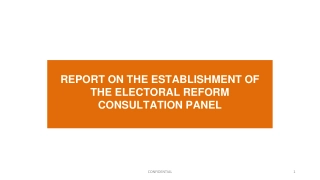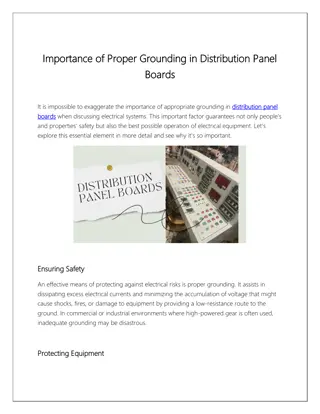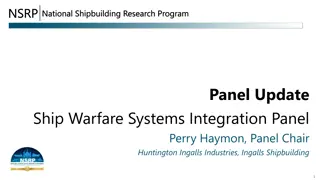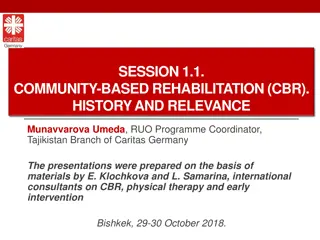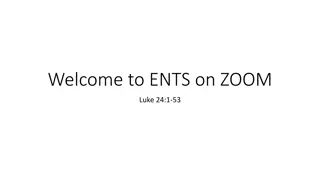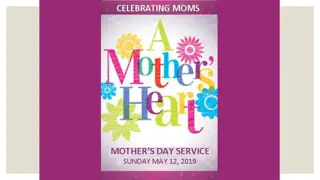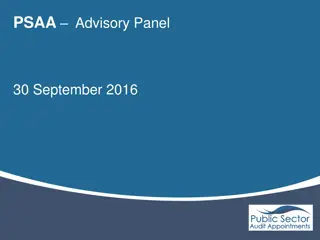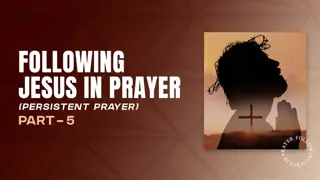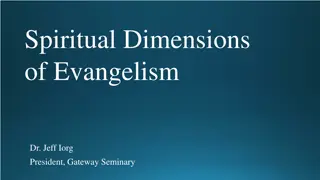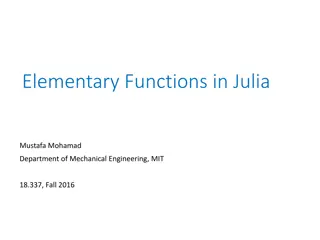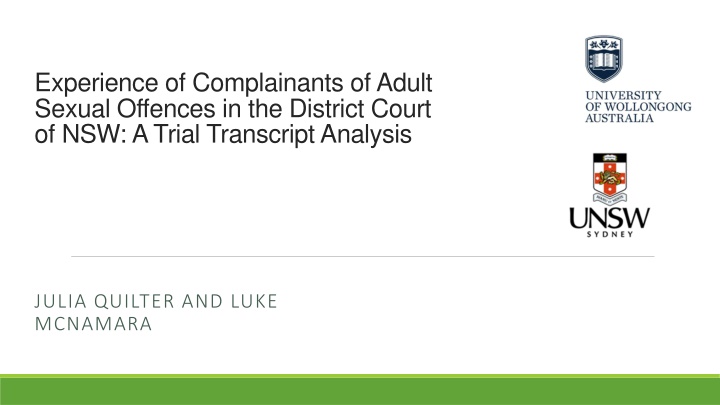
Analysis of Complainants' Experience in Adult Sexual Offences Trials
Explore the comprehensive analysis of complainants' experiences in adult sexual offences trials conducted in the District Court of NSW, focusing on legislative and privacy protections, examination approaches, judicial interventions, rules of evidence, and more to enhance the understanding and support for complainants during the legal process.
Download Presentation

Please find below an Image/Link to download the presentation.
The content on the website is provided AS IS for your information and personal use only. It may not be sold, licensed, or shared on other websites without obtaining consent from the author. If you encounter any issues during the download, it is possible that the publisher has removed the file from their server.
You are allowed to download the files provided on this website for personal or commercial use, subject to the condition that they are used lawfully. All files are the property of their respective owners.
The content on the website is provided AS IS for your information and personal use only. It may not be sold, licensed, or shared on other websites without obtaining consent from the author.
E N D
Presentation Transcript
Experience of Complainants of Adult Sexual Offences in the District Court of NSW: A Trial Transcript Analysis JULIA QUILTER AND LUKE MCNAMARA
ACKNOWLEDGEMENTS ACKNOWLEDGEMENTS Chief Judge of the District Court of NSW, Justice Derek Price AM, for granting permission for us to access trial transcripts. Judicial Registrar James Howard and Ms Lisa Freeman for facilitating identification and delivery of transcripts. Jackie Fitzgerald, Suzanne Poynting and Alana Cook at BOCSAR, for support and guidance at all stages of the project. Other members of the Research Team, Melissa Porter and Sarah Croskery-Hewitt, who provided excellent research assistance. The complainants in the sexual offence trials examined in this report. Australian Research Council Discovery Project Grant (DP200100101). 2
PROJECT AIM PROJECT AIM To investigate the experience of complainants in sexual offence trials in the District Court of NSW in relation to the: * operation of legislative and privacy protections * examination-in-chief and cross-examination approaches * prosecution responses * judicial interventions * rules of evidence * jury directions 3
RESEARCH QUESTIONS RESEARCH QUESTIONS What is the experience of complainants of sexual offences in the conduct of the trial? Are legislative and privacy protections for the complainant adhered to in the conduct of sexual offence trials? Do these protections offer sufficient support? What are some of the common themes in the cross-examination of complainants? Do lawyers and judges comply with rules of evidence? Which rules are/are not complied with? What support mechanisms are offered to and/or used by complainants (eg giving evidence by CCTV, being assisted by a support person)? Are there any improvements that could be made both to law and procedure to improve the complainant experience? 4
DATA DATA Transcripts from 75 sexual offence trials in District Court of NSW, 2014-2020: Sydney Downing Centre (27), Sydney west (14), regional NSW (19), circuit courts in NSW (15) 69 jury trials & 6 judge-alone trials 68 were first trials, 3 were subsequent trials after the first trial did not reach a verdict, and 4 were retrials after appeal all trials involved a male accused, with a male co-accused in two cases, and a female co-accused in one case in 72 trials there was a single complainant, and in 3 trials there were two complainants in 6 trials the complainant was male in 6 trials the complainant was identified as an Aboriginal person in 6 trials the complainant was identified as having a cognitive impairment in 2 trials the complainant was identified as being a sex worker 5
METHOD METHOD Ethics approval: University of Wollongong Human Research Ethics Committee 31,000 pages of de-identified transcript manually coded using NVivo 12+ and a customised codebook Qualitative content analysis of coded transcripts 6
STRUCTURE OF PRESENTATION STRUCTURE OF PRESENTATION 1. Operation of support & protections for complainants 2. Features of the Crown case 3. Features of the cross-examination of complainants 4. Trial judge use of jury directions 5. Overall conclusion and suggestions for further reform 7
SUPPORT AND PROTECTIONS FOR SUPPORT AND PROTECTIONS FOR COMPLAINANTS COMPLAINANTS 8
GENERAL AND SPECIFIC PROTECTIONS GENERAL AND SPECIFIC PROTECTIONS General Specific complainants not being personally cross- examined by an accused (CPA, s 294A) prohibitions/restrictions on sexual reputation/experience evidence (CPA, s 294CB) privilege in relation to sexual assault communications (CPA, Pt 5, Div 2) provisions relating to the re-use of evidence in retrials (CPA, Pt 5, Divs 3-4) protections for the giving of evidence by vulnerable witnesses (CPA, Pt 6) closed court ( in camera ) during a complainant s evidence (CPA, s 291) use of alternative arrangements for giving evidence e.g. remote location via CCTV (CPA, s 294B) entitlement to a support person while giving evidence (CPA, s 294C) non-publication orders to protect complainant s identity (Crimes Act, s 578A) Note: References to CPA are to current provisions, as amended by the Crimes Legislation Amendment (Sexual Consent Reforms) Act 2021 9
SUPPORT AND PROTECTIONS FOR COMPLAINANTS SUPPORT AND PROTECTIONS FOR COMPLAINANTS General protections present and operated effectively in most trials Specific protections (eg privilege re sexual assault communications) rarely operative, with the exception of sexual reputation/experience evidence Sexual experience evidence admitted in 50% of trials 10
CROWN CASE CROWN CASE 11
CROWN CASE CROWN CASE General courtesy Question of detail and expected terminology re sexual acts and body parts Format of examination-in-chief No use of narrative form (Evidence Act 1995 (NSW), s 29(2)) Formulaic approach to types of evidence admitted Real rape attributes 12
NSWCCA guidance on real rape assumptions NSWCCA guidance on real rape assumptions This court has repeatedly observed, in the context of a ground of appeal asserting that a guilty verdict(s) in a sexual assault trial is unreasonable, that it is not helpful to invite this court to make any assumptions as to how a victim of sexual assault might behave in given circumstances. It seems necessary to observe yet again that the criminal law has moved on from a time when sexual assault trials were overlaid with antiquated stereotypes about how a victim is supposed to behave. The court is not assisted by reliance upon such arguments in a ground contending that a sexual assault conviction is unreasonable. Harper v R [2022] NSWCCA 211, N Adams J at [184], [192] 13
CROWN CASE CROWN CASE Real rape attributes relied on by Crown Real rape attributes relied on by Crown Q. At any point did you yell or try and hit him or anything like that? A. No, I did try push him away but every time I did raise my voice or try hit him he would have - his temper would escalate. *** Q. did you continue the whole time, or was there a point where you did not resist? A. Resist. By the end I couldn t physically resist. I didn t have the physical strength to keep resisting physically.resisting physically. 14
CROWN CASE Challenging rape Challenging rape m myths yths Now, it might be suggested to you that [the complainant] made up these allegations because the accused was demanding a medical report in relation to a termination. You might ask yourself how would making this false report to the police about such serious matters change what the accused was asking her for, or hide that fact becoming known. [the complainant] said she was very offended and saddened by the accused s demands. *** The proposition that might ultimately be put to you is this woman is so unreliable and so vengeful and so prone to - well, flat-out making up outrageous untruths, that she then proceeded to go to the university where she made a complaint and a disclosure to a trained clinical psychologist. You might think that she tricked her into thinking she was truly distressed. She then went to hospital and had an intimate examination. She went to police, collected her clothes, did all of those things to generate a false complaint and I suggest, ladies and gentlemen, you just simply wouldn t come to that conclusion. 15
FEATURES OF COMPLAINANT FEATURES OF COMPLAINANT CROSS CROSS- -EXAMINATION EXAMINATION 16
FEATURES OF COMPLAINANT CROSS FEATURES OF COMPLAINANT CROSS- -EXAMINATION EXAMINATION Formalities and style Rule in Browne v Dunn Defence counsel: First I m going to take you through some of yesterday and I m going to take you through what the [two] accused also say happened. The propositions I m going to put to you will largely require a yes or no answer. Inconsistency as indicative of fabrication and/or unreliability 76% of trials Lying 95% of complainants accused of lying 73% accused of fabricating the allegation for an identified motive your evidence that you gave 17
Wide boundaries of relevant evidence Wide boundaries of relevant evidence DC: Had your borderline personality disorder or whatever else or however you think and behave caused you trouble with past relationships? CP: Objection, relevance your Honour. TJ: I will allow it. *** DC: Can you see me madam? C: Yes I can. DC: 2017 wasn t a good year for you was it? C: No, it wasn t. DC: Your son was taken off you by the Department of Family and Community Services on [day/month] 2017, is that correct? C: That s-- DC: Because you were considered by the department of being incapable of looking after him, is that right? 18
Reliance on real rape attributes Reliance on real rape attributes Absent real rape attribute Number of Trials (n = 75) % of Trials No immediate complaint 63 84% No physical resistance 38 51% No verbal communication of non-consent 40 53% No injuries 37 49% No force or threat 23 31% Absence of visible/demonstrable distress 25 33% At least one of these attributes 67 89% 19
Real rape evoking questions during complainant cross Real rape evoking questions during complainant cross- -examination examination Real rape attribute Examples from transcripts No physical resistance Q. Were you offering any resistance at this point in time? A. Resistance as in other than begging him to stop? Physical resistance? Q. Physical resistance? A. No because at that point in time I was trying, I was crying and holding the bed frame. Q. And you had the opportunity at that stage to say something to him if you did not agree with this? A. I guess so, but I didn t, because I was frozen. *** Q. I suggest to you, ma am, that you didn t indicate that you were not consenting. You never said to him, No. A. I did not give him consent to have sex with me. Q. You didn t suffer any injuries as a result of this incident? A. Physical injuries? Q. Yes, physical injuries? A. No. Q. He certainly didn t push you to the ground and push you to your hands and knees, did he? A. That s correct. Q. Nothing like that, there was no force, and there were no threats? A. That s correct. Q. [I]t never occurred to you before ringing Lifeline that maybe you should be ringing the police, that hadn t occurred to you before then, had it? No verbal communication of non- consent No injuries No force or threat Delayed complaint *** Q. You didn t immediately respond by text I ve been raped , did you? 20
TRIAL JUDGE DIRECTIONS TO JURY TRIAL JUDGE DIRECTIONS TO JURY Direction on lack of (or delayed ) complaint: CPA, s 294 only 38% of trials example of hybrid direction: if the complainant has not acted in a way you would have expected someone to act after being assaulted as she described, then that may indicate that the allegation is false but bear it in mind when considering this issue that there may be good reasons why the complainant did not raise the allegation immediately following the alleged assault and that a failure to do so does not mean that the allegation must be false. Differences in account direction: CPA, s 293A only 34% of trials 21
TRIAL JUDGE DIRECTIONS TO JURY TRIAL JUDGE DIRECTIONS TO JURY Single witness direction 25% of trials despite CPA, s 294AA (since 2007) and Ewen (2015) Example: So, in this case, there is only one witness as to the essential facts that are said to have occurred, and that is the complainant. That evidence is challenged by the accused. You should therefore look at the evidence of the complainant very carefully before coming to a conclusion as to what, in fact, occurred over these few days based on her evidence alone. (emphasis added) 22
CONCLUSIONS & CONCLUSIONS & SUGGESTIONS FOR FURTHER REFORM SUGGESTIONS FOR FURTHER REFORM 23
Trial transformation a work in progress Trial transformation a work in progress Discrete reforms to specific aspects of the sexual offence criminal trial generally working as intended However, the substance of how sexual offence trials are conducted has not been changed, including how the Crown frames its case, and in particular, how complainants are cross-examined by the defence Rape myths and stereotypes continue to heavily influence the framing of trials In cross-examination, complainants are routinely accused of lying and of having failed to behave in the way that a genuine victim of sexual violence would act 24
Further reform Further reform four suggestions four suggestions 1. A modified approach to framing the Crown case: The Crown says [the complainant] was very clear about her lack of willingness to have sexual contact with [the accused], but it comes back to are you satisfied whether there was an agreement. Okay. She doesn t have to say no. She doesn t have to fight him off. She doesn t have to physically resist him. The question for you to determine is whether she did, in fact, agree, and very clearly, the Crown says to you, she did not agree. 2. Greater limits on cross-examination questioning about the complainant 3. A review of all jury directions used in sexual offence trials 4. The introduction of ground rules hearings for all sexual offence trials 25
Criminal Procedure Act 2009 Criminal Procedure Act 2009 (Victoria) (as amended 30 July 2023) (as amended 30 July 2023) (Victoria) SECTION 389E Directions which may be given at ground rules hearings (1) At a ground rules hearing, the court may make or vary any direction for the fair and efficient conduct of the proceeding. (2) Without limiting subsection (1), the court may give one or more of the following directions (a) a direction about the manner of questioning a witness; (b) a direction about the duration of questioning a witness; (c) a direction about the questions that may or may not be put to a witness; (d) if there is more than one accused, a direction about the allocation among the accused of the topics about which a witness may be asked; (e) a direction about the use of models, plans, body maps or similar aids to help communicate a question or an answer; (f) a direction that if a party intends to lead evidence that contradicts or challenges the evidence of a witness or that otherwise discredits a witness, the party is not obliged to put that evidence in its entirety to the witness in cross-examination 26

